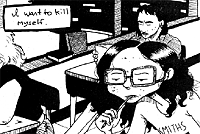>> The Book Review: The Horde
>> What About Bob? An interview with Bob Schreck, Part Two
More...

 Writer/Artist: Alex Robinson
Writer/Artist: Alex Robinson
Collecting issues #0-21
Price: $29.95
Publisher: Top Shelf Books
ISBN: 1891830198
BOX OFFICE POISON is the work of a young man. I don't mean this in a derogatory or even a diminishing sense - I mean simply that in his first significant work, Robinson has attempted to tell a story encompassing the place he lived, the people he encountered and the beliefs and feelings that he had, and used them to create a work of fiction. Not a thinly veiled memoir, and not a reaction to what he experienced, but a work of fiction as pure and as meaningful as he could create.
In this case, the work in question is a 600-page-plus graphic novel that took years to complete, encompassing a wide circle of friends and acquaintances, trying to make sense of their personal and professional lives. Relationships come together and break apart
Sounds familiar, don't it? Dozens of independent movies and small press novels have been written on the same subject this year alone. Well, Robinson knows he's not crafting the most unique story in the history of the world, and what distinguishes him from others who often tell such stories is his superior grasp of character and dialogue. Brian Bendis is the only other comics scribe that he could be compared to, but even then the comparison is worthless, given their divergent approaches.
Each is concerned with language and the way it can be used to illustrate characters and develop stories, but they use language in very different ways. Robinson uses naturalistic dialogue, as opposed to Bendis' machine gun patter. Robinson has a very acute feeling for the way people talk and the movement of conversations, the way they drift and sway, and often end up accidentally revealing more about themselves than they intend.
Art-wise, Robinson has a tendency to shift style though this can be effective; his characters become more expressionistic in the midst of strong emotions. Their faces contort, eyes widen, they speak in bold and often underlined words. Robinson uses the combination of dialogue and artwork to convey emotion throughout much of the book, and though he clearly feels unsteady in some moments, to be fair the most obvious offences are in the earlier sections of the book.
 The main objection I have to Robinson's art is that it just isn't as strong as his writing, and the story isn't what it could have been in another artist's hands. Still, Robinson is able to accomplish a great deal with his art when he sticks to the simple panelled layouts that dominate most of the book.
The main objection I have to Robinson's art is that it just isn't as strong as his writing, and the story isn't what it could have been in another artist's hands. Still, Robinson is able to accomplish a great deal with his art when he sticks to the simple panelled layouts that dominate most of the book.
The book takes it's time in setting up the various plot elements, but the primary one concerns Irving Flavor, a Golden Age cartoonist, and his fight for the rights to his old characters. The story is one that most people picking up the book would be familiar with, and it allows Robinson to illustrate some of his own feelings towards comics and the industry through Flavor's assistant Ed.
Sadly it is also one of the book's weakest plot lines. While most of the characters come across as complicated people, many of the comics-related characters come across more as stereotypes, from the angry indie comics magazine staffers, to Hildy, the sole woman at the magazine, to superstar artist Bobbie Garr, who mocks Flavor and his "whining" over his character's rights while gloating over how much money he makes drawing Flavor's characters.
The central character throughout the book is Sherman Davies, and I only call him the central character because his relationships form the crux of the story. A recent college grad, aspiring writer and bookstore employee, it's through Sherman that we meet most of the characters, and he provides one of the book's funniest sequences, about stupid people who bother bookstore clerks with their inane questions.
Then there's Sherman's friend Ed, the aspiring cartoonist, a character who starts out as a supporting one, but by the end seems to have taken over as the story's main character - a fact that Robinson seems to have also noticed, as he gives Ed the prologue to narrate. Ed is living at home after graduating from college. He's drawing a science fiction epic and working at his dad's hardware store. Only second to his desire to be a famous cartoonist is his desire to lose his virginity.
 Then there's the couple Sherman rents a room from, Stephen and Jane. He's a history professor planning to write a biography of Teddy Roosevelt, and she's a cartoonist working on a biography of Emma Goldman. The two are older than most of the other characters by a few years and they tend to remain in the background for much of the story, commenting on events. When they aren't naked, that is (which is a little too often for my taste).
Then there's the couple Sherman rents a room from, Stephen and Jane. He's a history professor planning to write a biography of Teddy Roosevelt, and she's a cartoonist working on a biography of Emma Goldman. The two are older than most of the other characters by a few years and they tend to remain in the background for much of the story, commenting on events. When they aren't naked, that is (which is a little too often for my taste).
There's also Dorothy, whose relationship with Sherman is one of the centrepieces of the book. Robinson's depiction of their relationship is what really impressed me reading over the book a second time; the way he captured their complexities and how he refused to make Dorothy the villain of the story, something that would have been easy to do. The result is something rare for comics, a relationship that does not have a happy ending, not because of anything that either one necessarily did, but because of who they are.
Ultimately, a tome this large has to be able to justify its length and the investment of time in reading it. Robinson's first work is ragged on the edges and unfinished in places; he hasn't quite figured out pacing and how to best juggle plot threads and weave them together seamlessly with character arcs. It's a raw and unfinished work, yes, but a lot of the sheer power and emotion comes from this rawness. It's not slick, polished and glossy.
It feels real. Realism is just a genre, it's not the be-all and end-all of art, but it's hard to get right. It's a lot easier to resort to crazy tricks and devices and structures than it is to tell a story as honestly as possible, to let the characters and their emotions speak for themselves.
BOX OFFICE POISON is a more than respectable debut, and it demonstrates that Robinson is clearly poised to be one of the industry's breakout talents in the next decade. I think that Robinson has enough talent to be able to figure out what worked and what didn't, and that his next work will be more developed artistically and something that is more narratively succinct. Whatever it is, whenever it comes out, I'll be standing in line to buy it.

This article is Ideological Freeware. The author grants permission for its reproduction and redistribution by private individuals on condition that the author and source of the article are clearly shown, no charge is made, and the whole article is reproduced intact, including this notice.


